When Is It Okay to Start Wearing Boots Again
Break-in pain is the ultimate paradox when you buy a new pair of boots. Ane twenty-four hours they'll fit like a dream, but for now the elements y'all love, like the stiff, high-quality leather and the thickness of the sole, can make you dread wearing them. But never fear — we've compiled the ultimate drove of tips and tricks to make breaking in tough boots as painless equally possible. Think, this is a break in procedure, so it may take some fourth dimension. Hither's how.
1. Commencement With the Correct Size
Forget what you've heard about the leather stretching — there'due south nothing you lot can do well-nigh a pair of boots that's likewise minor, back-to-front. If your toes are cramped or the width of your foot hangs over the footbed, no corporeality of breaking in is going to fix information technology. On the other hand, as well-big boots will never be more than cicatrice machines. Blisters are formed where there's friction, and if yous're sliding effectually with every pace, y'all'll never get past the break-in stage.
If y'all're not certain exactly what size you are, go to your local shoe store and become measured on a Brannock device. It's a helpful starting bespeak, though not all manufacturers are true-to-size. If possible, try on boots in person earlier yous buy them, and experiment with a half size larger and smaller than your bodily size. If you have to buy online, be sure to read our reviews and consider ordering a couple of sizes and returning one of them when you're confident. A lot of boot brands are designed to fit best when yous get a half size down, only not all! Luckily, our reviews have you covered.
[Acquire more than: The Ultimate Guide to How Boots Should Fit]
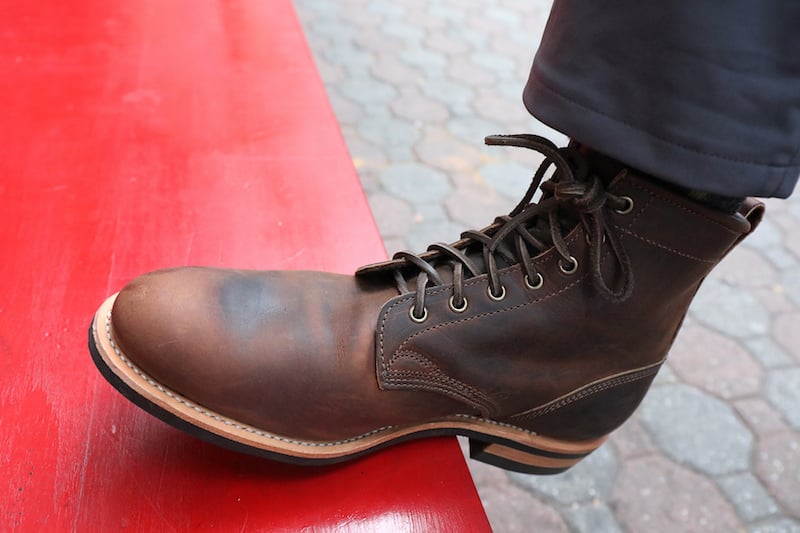
The Dayton Service Kicking is one of my favorites of all time — just that break in…
two. Wear Thick Socks — Inside
Start with the thickest sock you have (or two if you can manage information technology!) and habiliment your new boots around the house. This will help you lot figure out if they're the right size without getting them muddied, then y'all can yet render them. Information technology'll likewise begin stretching the leather.
Out-of-the-box leather is as potent every bit it will ever exist, and softens and stretches best with a combination of gentle force per unit area, heat, and moisture. That'south why boots are easier to suspension in during summer months — the combination of warmer exterior temps and increased moisture from your sweaty feet (gross just real) is the ideal set of weather condition for loosening the leather fibers. The beefy socks will mimic some of this by warming up your anxiety and pressing on the upper, helping it mold to the shape of your foot.
3. Slap on a Rough-and-tumble
Once y'all've worn your new boots for a scrap, information technology'll be pretty clear where blisters volition form on your human foot. You don't have to be a martyr to them – simply notation those places and slap on a band-help the first few times you wear your new boots out in the world. A fiddling bit of preventative medicine goes a long style here. Big, fabric band-aids work all-time for this, as the plastic ones tend to go glace and don't stay in place likewise.
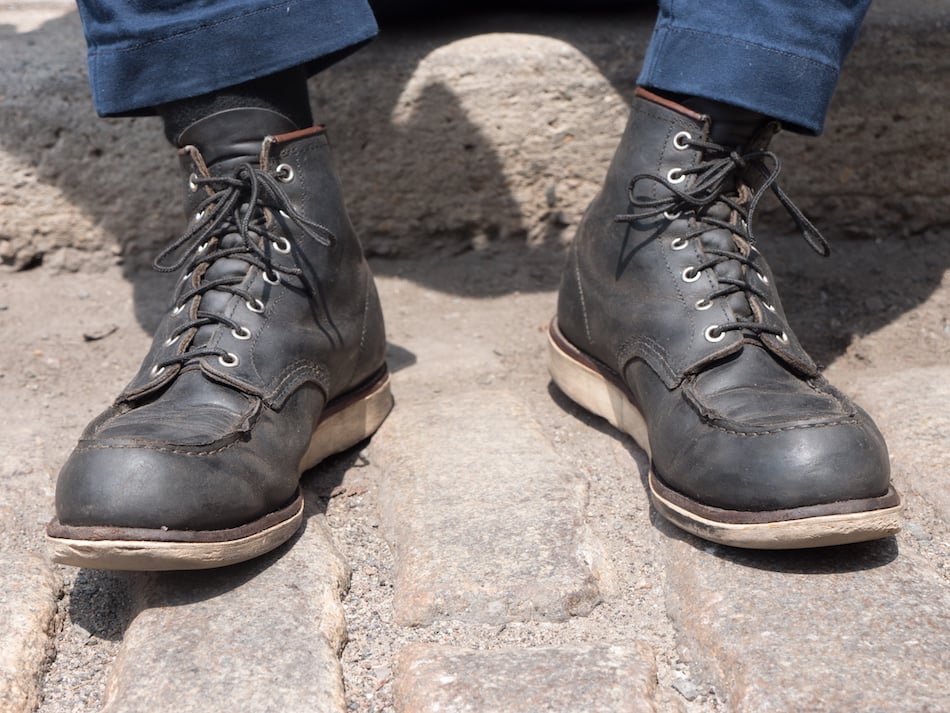
My kickoff pair of boots, the Crimson Wing Moc Toe. Break in was not fun.
4. Bring Your Quondam Boots With You
Don't commit to a 12-hr twenty-four hours in your new boots. No matter how comfortable they may be in your house, your arches will need a interruption after a few hours. Information technology's best to vesture new boots early in the solar day, when your feet are fresh (your feet expand throughout the day every bit the weight of your torso presses on them), and accept them off after 2 or three hours. Leave your former boots by your desk or in the trunk of your car and bandy them out when you start to feel discomfort.
[Best: 10 Best Boots for Wide Anxiety]
5. Give It a Break
Equally tempting as it may exist,don't clothing your new boots many days in a row. The wet from your foot takes more than a nighttime to evaporate fully, and giving the leather a day or two in between wears will not simply requite your anxiety a much-needed pause, information technology will requite the boots time to dry fully earlier you wear them again.
Every bit an added bonus, using this method throughout the lifetime of your boots will keep the foot-stink to a minimum. Nosotros recommend using shoe trees between wears to help draw out the moisture and and then the boots retain their shape. I get that this might be tough if y'all need to pause in new work boots, it'due south not like you tin can just have a twenty-four hours off of work because you demand to interruption in new pair of boots.
[Acquire more: 3 Reasons Your Boots Need Shoe Trees.]
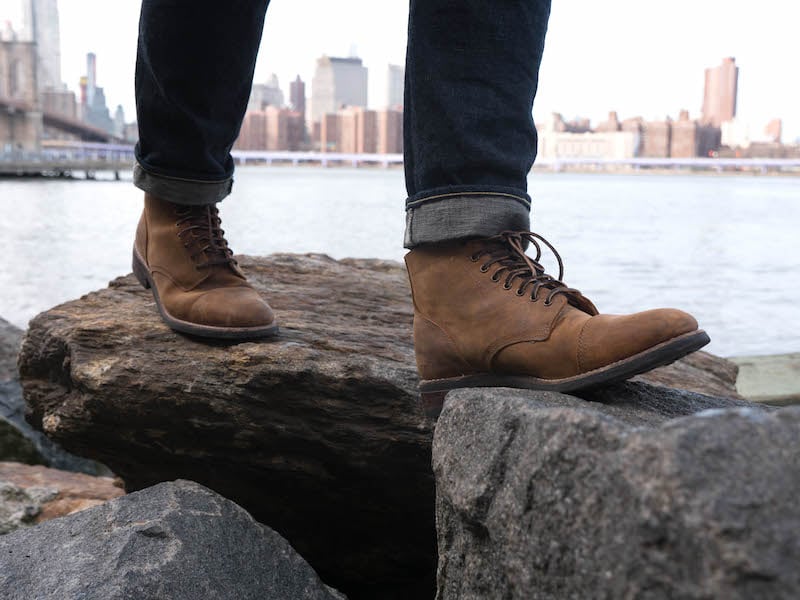
The Thursday Vanguard kick.
6. Work the Curve
There are two main places where boots curve: at the ankle, and just below the toes, at the ball of the foot. Those are the places that the leather will flex every bit you lot take a step, and need some work during the initial break-in. When you've worn your new boots for a while, just after you take them off, hold the kicking in your hands and work the leather, bending the sole back and forth at the pucker and burdensome the leather fibers around the heel and ankle. Don't worry near being also gentle with them either. Yous're non going to ruin your boots, you're just speeding up the process that would naturally happen as you walk around in them.
vii. Scuff Up the Heels
Heel slippage is a super common trouble (peculiarly with boots that take a smooth leather lining) and as nosotros know, friction causes blisters. Over fourth dimension, wearing the boots creates a "heel pocket" in the inner heel surface area, which is why boots don't give you blisters forever.Yous can speed the evolution of the heel pocket by taking a slice of fine-grain sandpaper and lightly sanding the inside of the heel area. You might be cringing at the idea of damaging the leather, merely you don't need to go crazy with it – simply scuff it a bit so that the boot can grip your sock a little meliorate and reduce the friction.
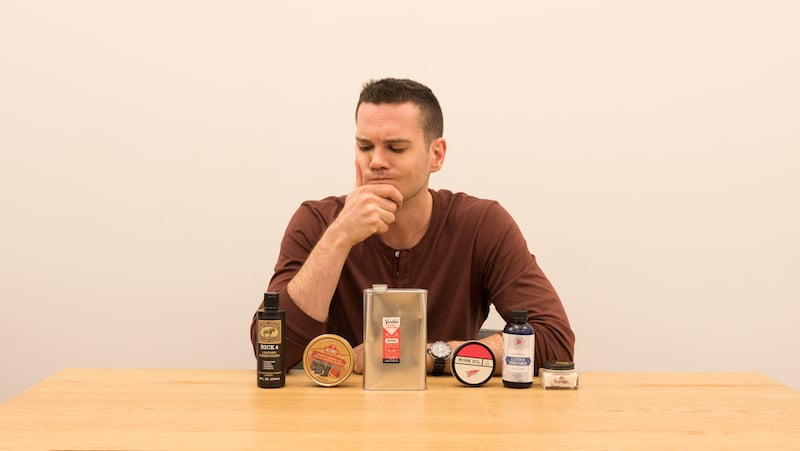
8. Treat Your Leather
This method is most useful if the leather upper feels too tight:adding moisture in the form of a leather softener, similar Tenderly Leather Softener , or a conditioner like Venetian Shoe Foam , tin can increase the give of the fiberdue south. Remember: moisture helps leather stretch. Just be careful not to over-condition, which tin brand the material floppy. A piddling conditioner goes a long way.
[Related: The v Best Boot Conditioners On the Market]
9. Stretch Information technology Out
If you lot've got a lot of tightness in the width of the boot (and y'all're sure it fits right everywhere else) then a shoe stretcher is the manner to become. Information technology looks a bit like a cedar shoe tree, except with a creepo that you tin apply to increment the width of the wooden human foot. All-time used in combination with a conditioner or leather softener to break in your new boots. You just insert it into the boot, crank information technology open, and leave it there for 6-8 hours.

The Oak Street Trench Boot
10. Try A Different Lacing Combo
If you're encountering tightness effectually your arch or ankles and want to give your pes a little more room to flex, skip some of the eyelets when yous lace upwards your boots. Afterward all, the point of the break in is to stretch the leather, not the laces. This can exist particularly helpful when you lot've got a pair of boots with a gusseted natural language, which adds extra bulk to break in.
11. Accept Your Pair of boots to a Professional
If you really tin't stand the idea of breaking in your own boots, then a cobbler can help. They have specialized stretching tools that can expand but the problem areas on a pair of boots, or add padding to an insole or arch. A quick Google search for "shoe repair near me" or "cobbler near me" will plow one up. Only keep in listen that you might need to exit your new boots with them for a few days.

12. Don't Rush It
A final word of alert: there are a lot of terrible DIY tips on the internet for "breaking in boots fast!" Don't purchase it. Wearing your boots despite the discomfort tin cause problems. At that place's a fine line when you break in new boots, you don't want accidentally to damage them.
None of those methods are as good every bit taking your time.
How Non to Suspension in Boots
We wrote an entire article on what not to do to stretch or compress a pair of boots. Most of those manufactures on the internet are based on old-wives' tales perpetuated past recycling content from old bulletin boards, and well-nigh of those methods can hurt your feet or damage your boots.
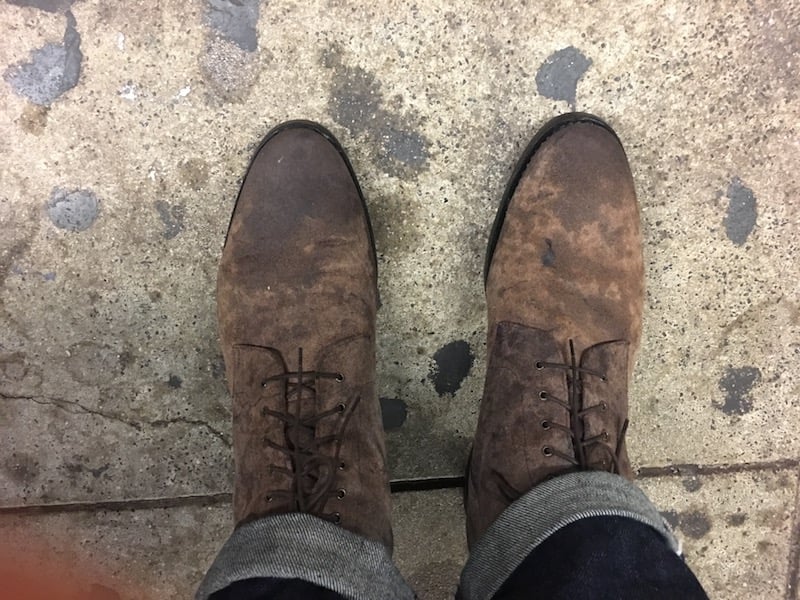
Don't fill your boots with water and allow them dry.
This is oft recommended for work boots and hiking boots. This myth is perpetuated by military types for speedily breaking in boots, and that might work if you're in the military, just seems like it's just bad advice that won't die, because wearing wet boots has tons of downwardly sides for your foot and boot health. Especially, if you own heritage boots with cork and other oldy-timey materials. Too much h2o tin cause the leather and other materials (similar cork midsoles!) to rot, warp, or compress.
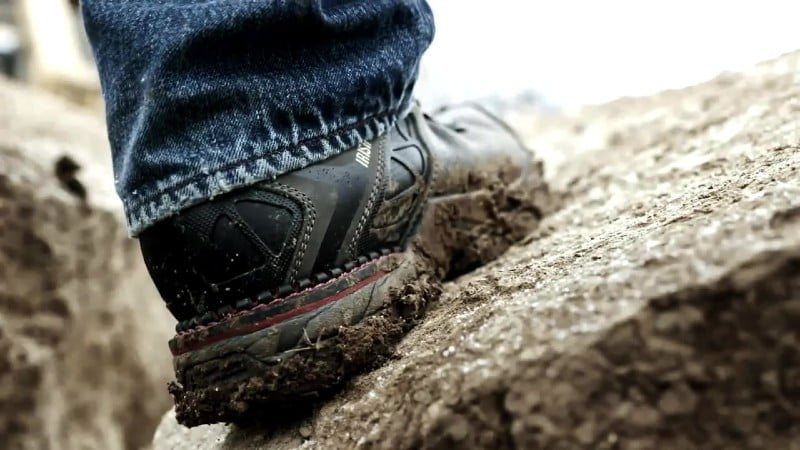
Work boots, military machine boots, and hiking boots are built differently from a pair of heritage boots. They take more than synthetic materials like nylon, Poron, and EVA that are more than durable if they get moisture. These boots dry quicker and won't rot as easily. Also, there's less leather, or the leather has been treated to prevent it from drying out and cracking. If y'all demand to break in a pair of piece of work boots rapidly, and y'all know they are mostly constructed, simply use the same communication we gave above.
Don't wear wet socks effectually
You want to intermission in new boots, not your anxiety. Wearing moisture socks can crusade blisters. Likewise, it can cause your boots to get really stinky. As y'all vesture wet socks and your boots heat up and bacteria will grow. When you lot get out your boots to dry overnight, you're basically creating the perfect environment for mold and other microorganisms to invade your boots. These are really tough to get out, and you lot might be stuck with stinky boots. Besides, wet socks are guaranteed to give you blisters.
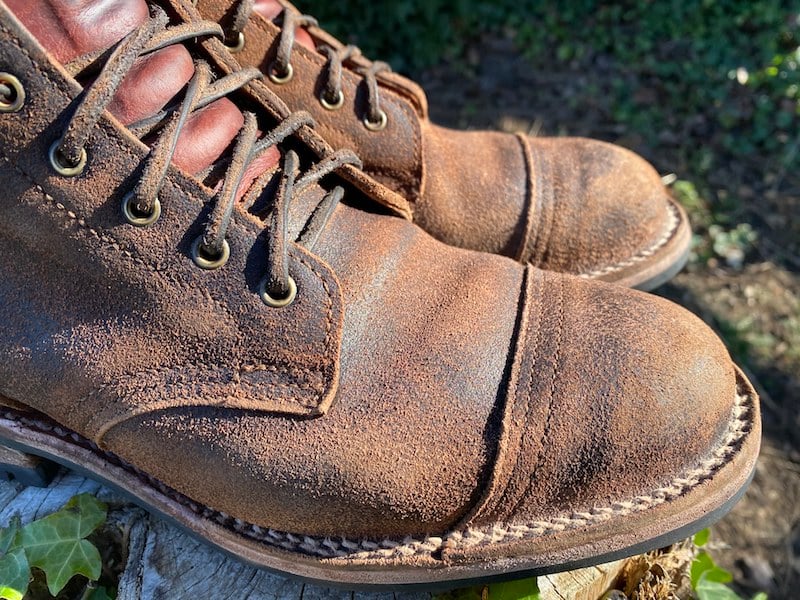
Don't smash your boots with a pilus dryer.
This is one of the worst ways to break in new boots. New boots have a lot of oil in the leather to soften it and continue it from getting brittle. Boots basically come with leather conditioner already practical. Rut will remove these oils from the leather. That's why a lot of these so-chosen tips recommend adding more than conditioner to the leather after you accident dry them.
I've seen information technology touted every bit a mode to stretch, shrink and intermission in boots. This is i of the worst means to break in make new boots. New boots take a lot of oil in the leather to soften it and keep it from getting brittle. And then boots basically come with leather conditioner already applied to protect them from rut and dry air which remove the helpful oils from the leather. That's why a lot of these so-chosen tips recommend calculation more conditioner to the leather later on you blow dry them.
This method as well includes get your boots we to some caste. So you have all of the problems of soaking the boots combined with the boosted bug of moisture boots. The leather won't stretch much, you'll waste leather conditioner, your boots don't break in as much as wearing them or bending them, and you may cause excessive damage to your boots.
A pilus dryer volition suck all the natural wet correct out of the leather fibers.
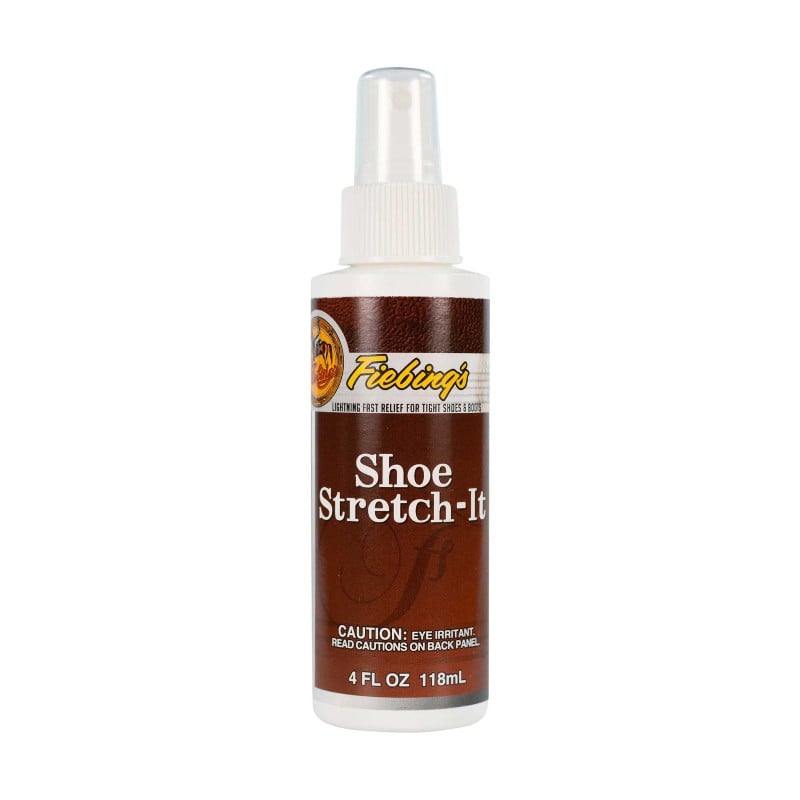
Don't spray your boots with a combination of booze and water.
Spraying your boots with alcohol and water to stretch, widen, or soften up the leather in areas where the boot or shoe is tight, is something cobblers do. Fiebing even sells shoe stretching spray that is only water and alcohol, but for breaking in boots, simply wearing them and bending them is much amend. If you have a problematic spot where the leather is likewise stiff like on the ankle, a good cobbler can soften the leather in that spot.
You want to avoid the alcohol and h2o spray method because information technology also strips out the oils from your new boots. Yous demand to utilize leather conditioner, which can be expensive. Likewise, y'all tin can cause the dye in the leather to fade. That may non be too important for a pair of work boots or hiking boots, merely you definitely don't want to damage a pair of $400 dress boots.
Alcohol will eat the dyes out of your boots. Information technology will increase the brittleness of the leather, which tin lead quickly to cracking and other damage.
Wrapping Up
The internet is full of terrible ideas – use your common sense.
Go slow, pay attention, and think that breaking in quality boots is a process that takes a couple of weeks, tops – inappreciably a trade-off when yous think near the years of comfortable wear you'll get out of them after it's washed.
[Related: My list of The Best Boots]
The following 2 tabs change content beneath.
- Bio
- Latest Posts
Mel Compo is a writer, editor, and general discussion-geek from Brooklyn, New York. When they're not writing almost the finer side of men'southward footwear they can be establish lurking effectually the streets, trains, and museums of NYC, ostensibly doing something urgent merely actually just looking around for menswear way inspiration.
Source: https://stridewise.com/how-to-break-in-boots/
Post a Comment for "When Is It Okay to Start Wearing Boots Again"